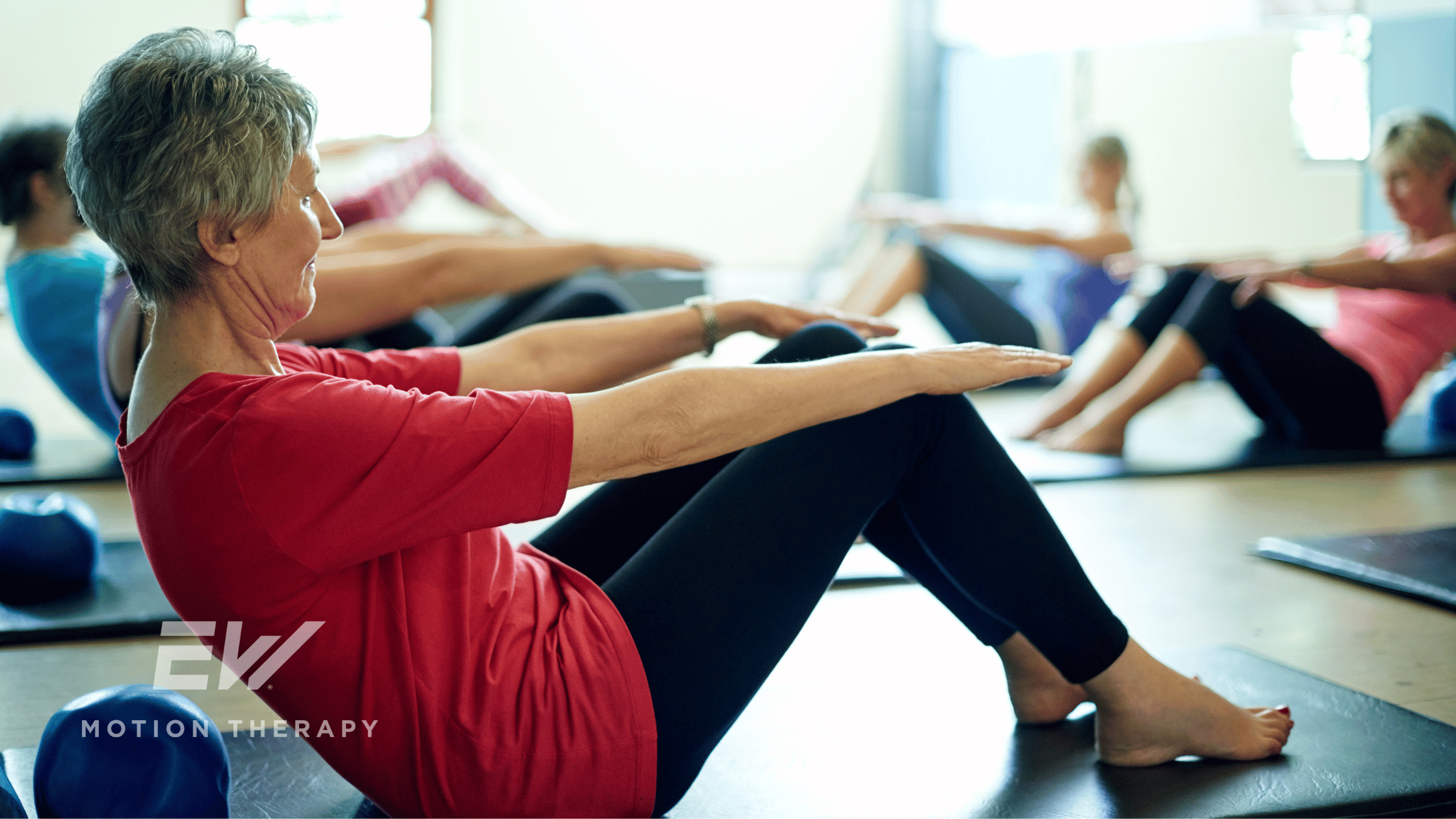The Benefits of Pilates for Osteoporosis: A Safe and Integrative Approach

Licensed Physical Therapist, PT, DPT // Lead EW Yoga Instructor // EW Pilates Instructor // EW Motion Therapy Homewood
Pilates, a low-impact exercise that emphasizes core strength, spinal alignment, and mindful movement, has grown in popularity among individuals looking to improve overall fitness and wellness. For those with osteoporosis, Pilates offers unique benefits that can enhance bone health, improve balance, and reduce the risk of fractures. However, it’s essential to approach Pilates with the proper modifications and understand how it fits within a broader osteoporosis care plan. This article explores the benefits of Pilates for osteoporosis, how to practice it safely, and how it can complement other treatment strategies.
Understanding osteoporosis
Osteoporosis is characterized by weakened bones, making them more susceptible to fractures. It primarily affects older adults, particularly women post-menopause, but men can also be at risk. Critical challenges of osteoporosis include an increased risk of fractures, especially in the spine, hips, and wrists, and a loss of mobility and independence.
Pilates can be an effective exercise regimen for those with osteoporosis due to its focus on controlled, weight-bearing movements that strengthen muscles and improve balance. These benefits are critical for osteoporosis management because they help to support the skeletal structure, reduce the likelihood of falls, and promote overall physical health.
Benefits of Pilates for osteoporosis
Improving bone density and strength
One of Pilates’s primary benefits for individuals with osteoporosis is its potential to help maintain or improve bone density. While Pilates is generally a low-impact exercise, it includes weight-bearing and resistance exercises, which are known to stimulate bone growth. Exercises that involve the use of light weights, resistance bands, or the body's own weight can create the necessary stimulus for bones to adapt and strengthen over time.
Enhancing core strength and stability
Pilates emphasizes core strength, including the abdomen, lower back, hips, and pelvic muscles. A strong core is crucial for individuals with osteoporosis as it helps stabilize the spine and reduce the risk of vertebral fractures. Enhanced core strength also aids in posture correction, which is essential for reducing stress on the spine and maintaining proper alignment during daily activities.
Improving balance and reducing fall risk
Falls are a significant concern for those with osteoporosis, as they can lead to serious fractures. Pilates incorporates balance training and proprioception exercises, which improve an individual’s ability to control their body position in space. Enhanced balance reduces the risk of falls, making Pilates a valuable tool in osteoporosis prevention.
Increasing flexibility and range of motion
Osteoporosis can lead to stiffness and reduced mobility, particularly in the spine and hips. Pilates includes gentle stretching and flexibility exercises that help maintain joint mobility and muscle elasticity. This is important for preventing the limitations that can accompany osteoporosis, such as a hunched posture (kyphosis) or restricted movement.
Promoting mind-body awareness
Pilates is not just a physical exercise - it also emphasizes mindful movement and body awareness. This aspect of Pilates encourages individuals to move with greater care and attention, which is especially beneficial for those with osteoporosis who need to be mindful of their movements to avoid injury. Developing a greater sense of body awareness can also improve confidence in physical activities, contributing to a more active and fulfilling lifestyle.
Modifying Pilates for safety with osteoporosis
While Pilates offers many benefits, individuals with osteoporosis must modify certain exercises to ensure safety and prevent fractures. Here are some considerations for practicing Pilates safely:
Modify high-risk movements
Certain Pilates exercises involve spinal flexion (bending forward) or twisting motions that can increase the risk of spinal fractures in individuals with osteoporosis. Deep forward bends should be modified by smaller movements or using the support of the reformer or tower. Focus on exercises that promote spinal extension (gentle back bends) and lateral movements that support spine strength and flexibility without compression.
Focus on low-impact, weight-bearing exercises
Low-impact exercises are gentler on the bones while still providing the benefits of weight-bearing activity. Pilates exercises such as leg lifts, bridges, and standing balance exercises can be effective for building strength without putting undue stress on fragile bones. Additionally, using a Pilates reformer or tower can allow for more controlled movement in positions that would usually stress the body too much.
Incorporate resistance training with professional observation
While resistance is beneficial for bone health, it’s essential to use appropriate levels of resistance to avoid strain. Pilates often uses resistance bands or light weights, which can be adjusted based on individual needs and fitness levels. Start with minimal resistance and gradually increase as tolerated, always under the guidance of a qualified instructor familiar with osteoporosis.
Work with a qualified instructor
A Pilates instructor who has experience working with individuals with osteoporosis can provide personalized guidance and modifications to ensure safety and effectiveness. They can help tailor the exercises to your specific needs, provide the proper cues in a group environment for safe movement, and monitor your form to avoid movements that could cause harm.
Integrating Pilates into an osteoporosis care plan
Pilates should be viewed as a complementary component of a comprehensive osteoporosis care plan, which may include other forms of exercise, medication, dietary adjustments, and lifestyle modifications. Here’s how Pilates integrates with other aspects of osteoporosis management:
Complementing weight-bearing and aerobic exercises
While Pilates is excellent for core strength, balance, and flexibility, it should be combined with other weight-bearing activities like walking, dancing, or low-impact aerobics, essential for promoting bone health. These activities can help to further stimulate bone growth and improve cardiovascular health, contributing to overall wellness.
Supporting a balanced diet and nutrition
Proper nutrition plays a crucial role in osteoporosis management. A diet rich in calcium, vitamin D, and other bone-supportive nutrients can enhance the benefits of an exercise regimen like Pilates. Incorporating Pilates into a routine that includes a balanced diet ensures a holistic approach to bone health.
Integrating with physical therapy
Physical therapy can provide a solid foundation for individuals with osteoporosis. Physical therapists can assess your current physical condition and recommend specific Pilates exercises or modifications to ensure they are safe and effective for your needs. They can also help monitor your progress and adjust your exercise plan as necessary.
Medication and medical management
Pilates and other exercises are key to managing osteoporosis, but they should be used in conjunction with medical treatments prescribed by healthcare providers. Medications that improve bone density, such as bisphosphonates or hormone-related therapies, work synergistically with exercise to optimize bone health.
Pilates offers many benefits for individuals with osteoporosis, from improving bone density and muscle strength to enhancing balance and flexibility. However, it is crucial to approach Pilates with appropriate modifications to ensure safety and avoid movements that could increase fracture risk. When integrated into a broader osteoporosis care plan that includes other forms of exercise, proper nutrition, physical therapy, and medical management, Pilates can be a valuable tool in managing osteoporosis and promoting overall health and well-being.
If you have osteoporosis and are considering starting Pilates, consult with your healthcare provider and seek guidance from a qualified Pilates instructor with experience in osteoporosis care. With the right approach, Pilates can help you move confidently and safely, supporting your journey to stronger bones and better health. When you come in for a Pilates session at EW Motion Therapy, you receive a personalized program tailored to your needs and goals. Even our group classes are limited to four participants to ensure your instructor can give you their undivided attention. To learn more about what Pilates can do for your health, click the button below to download our answers to 20 frequently asked questions.


